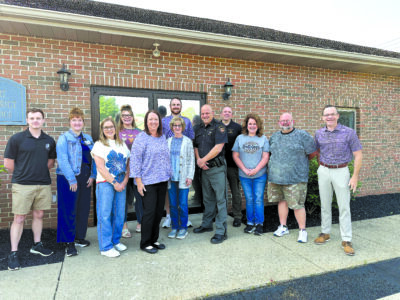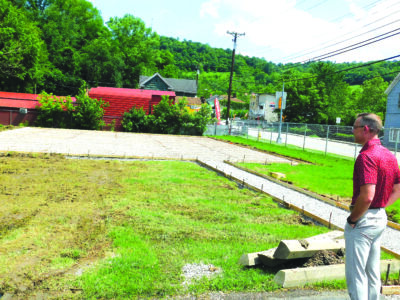Cities, county brainstorm on water problems

T-L Photo/ROBERT A. DEFRANK Engineer Jeff Vaughn, right, speaks about the state of St. Clairsville’s water service Wednesday during a brainstorming session including Safety and Service Administrator Jim Zucal, left, and Councilman Perry Basile.
ST. CLAIRSVILLE — The Belmont County seat is seeking to collaborate with other communities to meet pressing demands from the state.
Mayor Kathryn Thalman has until Tuesday to respond in writing to mandates from the Ohio Environmental Protection Agency and give a forecast for the next 50 years, including required improvements in the next two years. She held a two-hour meeting Wednesday that included officials from the cities of St. Clairsville and Martins Ferry and from the county.
Taking part were engineer Jeff Vaughn, who is analyzing the water system; St. Clairsville City Council members Perry Basile and Terra Butler and Safety and Service Director Jim Zucal; Belmont County Water and Sanitary Sewer Director Kelly Porter and Commissioner J.P. Dutton; and Martins Ferry Mayor John Davies, Service Director Andy Sutak and Water Superintendent Bill Suto.
“They want to see something in two years. They want a plan from source to tap,” Zucal said of the OEPA, noting options put forward by the agency included connecting to Wheeling’s water system or Martins Ferry’s system, having water provided by Belmont County, selling the St. Clairsville system to Aqua Ohio or building a new water plant.
Thalman said the OEPA also wants St. Clairsville to move away from surface water provided by a reservoir. Vaughn said the city asked the OEPA for more time during a meeting last week in Columbus.
“The city doesn’t want to spend money in the wrong place, but we need a five-year gap here to get the distribution system under control and … supply the water long-term,” Vaughn said.
Zucal said the city plant produces 600,000 gallons of water per day but bills for a little more than 300,000 gallons.
“Our water loss in January this year was around 48 percent. It fluctuates, sometimes as high as 57 percent,” Zucal said, adding one major leak was found about three weeks ago. “We know there’s more out there.”
Porter and Suto suggested focusing on the distribution system and cutting water leaks. Suto said reducing water loss from leaks would mean a significant savings to the city. Vaughn said non-functioning water meters and unmetered municipal buildings could also account for water loss.
“The city of Martins Ferry’s prepared to put some of our men out here to help you guys find your water loss,” Davies said.
Thalman will also begin ordering new water meters. She said the cost of meters and of paying Martins Ferry workers will be determined.
Suto said he hoped these steps would convince the OEPA to give St. Clairsville more time.
“You sit down with the EPA … (and say), ‘Are you going to force us to make a bad decision?'” Porter suggested. “You can’t control what the previous administration did.”
“But it’s … in my lap,” Thalman said.
In terms of a water source, Davies said Martins Ferry could produce 5 million gallons daily.
“It’s just a matter of getting it here,” Davies said.
Some options to provide water from Martins Ferry include using existing lines through Bridgeport and Brookside and installing a pump station at Blaine Hill, but Porter said some of the lines could be 70 years old. There also could be some impact on water quality due to mixing surface water produced by St. Clairsville and ground water treated in Martins Ferry. Porter said other another option is to use a waterline along U.S. 40 that dates from the 1980s. Another suggestion was to use multiple sources from the county.
“These are real things that could happen without too much impact to anything else,” Porter said. “Don’t let (the OEPA) force you into going into debt somewhere where you shouldn’t right now. Whoever it is, Martins Ferry … whoever, they’re going to charge you for that water.”
Porter and Dutton suggested the city take Belmont County representatives to future talks with the OEPA.
“It’s not about taking over someone’s distribution system,” Dutton said.
“Everybody has their own identity,” Suto said. “If you give your water plant and water system away, you’ve lost your backbone of St. Clairsville. You’ve lost your identity.”
“I agree. It’s too precious a commodity,” Thalman said.
Zucal stressed the costs of improving or maintaining the system: “We need to think about numbers, we need to think about engineering, and for the council people we need to think about funding, because all that comes with a price tag.”
“You put water debt onto wherever it applies and it’s minimal amounts per month. It’s not like you have to pay it all back tomorrow,” Suto replied.
Thalman said funding could be available. She said the Rural Community Assistance Partnership could assist Martins Ferry in finding leaks in St. Clairsville’s system.
In answer to a question from Davies, Thalman said the OEPA has not specified the fines for failing to meet mandates.
During the session, talk turned to greater regional cooperation. Porter said many communities have water issues. Afterward, Thalman said the OEPA has spoken in favor of greater connectivity.




